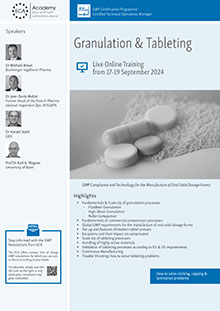Shared and Dedicated Facilities: EMA publishes final Guideline on Setting health based exposure limits (PDEs)

Recommendation
17-19 September 2024
GMP Compliance and Technology for the Manufacture of Oral Solid Dosage Forms
The EMA has now published the long awaited final version of the Guideline which sets the exposure limits of products manufactured in so-called shared facilities (multipurpose). In other words, the question is how much from a product can be carried over in another one (cross contamination) without posing any risk to patient health. The previous EMA Draft Guideline was released in January 2013.
The possibility to deviate from the main procedure on setting limits if adequately justified is a major change highlighted several times in the document. Also the use in the API production is now defined as optional which means that the main principles can be used when it's necessary.
As expected, there has been no change to the basic calculation of the limits (PDE = Permitted Daily Exposure). However, the No-Effect Level coming in the formula is now the NOAEL = no-observed-adverse-effect-level (previously NOEL). This could lead to discussions about what ‚adverse' is and what isn't.
The limit for genotoxic residues of intermediate products is now the same as for genotoxic impurities from the manufacturing process itself: 1.5 µg (instead of 0.15 µg/day in the draft).
According to the guideline, the PDE approach may not apply to macromolecules since these molecules can be chemically or thermally inactivated. The observation of the completeness of an inactivation or possible degradation products isn't addressed in the present document.
Development products from Phase I and II have been newly added, for which limited toxicological or pharmacological data are available and make thus the estimation of the PDE very difficult. Here, scientific publications are mentioned which describe alternative procedures.
The new section 6 now contains more details about how the authority expects the derivation of the PDE values incl. the necessary correction factors and the lead effects. A summary of this derivation is also explicitly required for GMP inspectors who - in practice - have to deal with the plausibility of these scientific reports and with e.g. derived limits for cleaning validation.
The transitional period - which is described in several stages - is also new. The transitional period for new products or products introduced for the first time into shared manufacturing facilities is 6 months from publication of the guideline. In the guideline the 1st of June 2015 is written as the date for coming into effect. For products already manufactured in shared facilities the transition period is 1 year. For shared facilities were only products for veterinary use are manufactured, the transition period is 2 years.
Now the interesting question is how welcome and ranked this guideline in practice will be and how deviating approaches from the procedure described will be assessed. In the drafts of Chapter 5 of the EU GMP Guide (Production), EMA's Guideline and the procedure for the calculation of PDEs have been explicitly named. This reference is missing in the finale version. Yet, the EMA guideline refers to the chapters 3 and 5 of the EU Guide and the required scientific and risk-based approach on the handling of products in multipurpose facilities. In the chapter on cleaning validation of the current draft version of the Annex 15 of the EU GMP Guide (Validation & Qualification) the reference to the EMA Paper is still available. One should expect further changes to the finale version of Annex 15 - finally, one will have to wait for the finale version of the document. See also: Quo Vadis Cleaning Validation.
You can find the final version of the Guideline "Setting health based exposure limits" on the website of the EMA. Please find also recommended events below
Related GMP News
GMP Conferences by Topics
- General Quality Assurance and GMP Compliance Topics
- Hygiene
- General Microbiology Topics
- Regulatory Affairs
- Development
- General Analytics Topics
- Good Distribution Practice
- Sterile Manufacturing
- Computer Validation
- General Qualification/Validation Topics
- General Engineering Topics
- APIs/Excipients
- GMP Basic Training Courses
- Medical Devices and Combination Products
- Packaging and Packaging Material
- Data Integrity
- Qualified Person (QP)
- GMP Auditing
- Documentation
- Cleaning Validation
- General IT Compliance Topics
- Impurities
- OOS / OOE / OOT
- Material Testing
- Validation of Analytical Methods
- Analytical Instrument Qualification
- Stability Testing
- Microbiological Testing
- Technology
- General Manufacturing Topics
- Solid Dosage Forms/Semi-Solid Dosage Forms
- Biotechnology/Blood/ATMP
- Herbal Drug Products/Cannabis/Radiopharmaceuticals
- Others




